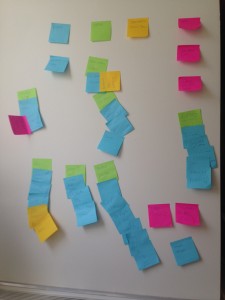This piece originally appeared on the blog of the Tri-Co Digital Humanities Initiative, who have sponsored Brenna Levitin (BMC ’16) as our intern this summer. In addition to the two posts she has published on the Tri-Co DH site, Brenna has published regular updates on this blog. To catch up with her summer work, read her thoughts on a find in the 1989 Alumnae Bulletin, her consideration of silence in the archives, and her approach to using digital tools to address the silence.
When I last wrote, I optimistically assumed that July would be for oral histories and August would be for creating the exhibit. In reality, oral history work has bled over into August, and I’ve actually been building the exhibit since mid-July. I also described the analog/digital split in my project, which has evolved; as August has worn on, I’ve simultaneously handled our first donations of alumnae/i materials (flyers, photos, etc) while drafting the actual pages of the exhibit.
As the first Scalar project undertaken at Bryn Mawr Special Collections, I am conscious of my duty to document the process. Scalar has offered me enormous freedom to design the exhibit in any multi- or non-linear way that I wish. That freedom is not without a price, however; non-linear documentation means that pages can fall through the cracks; technically contained within the exhibit but unlikely to fall within the viewer’s path. Recently, I struggled to decide how to organize the exhibit in a way that would not imply that this history is complete while still showcasing every possible morsel of information that I gathered.
I settled on a three-pronged attack: first, navigation through themes like ‘Campus Climate’ and ‘Outside the Bryn Mawr Bubble;’ second, navigation through type of archival material (Newspapers, Publications, and Conversations with Alumnae/i); and yes, third, chronological. I understand the need for a complete chronology, but only with a blinking, red disclaimer on the front which acknowledges that this is not anything like a complete history.
Because I’m undertaking a new type of project, there is no established way to explain the set-up. Therefore, to illustrate my layout I have to describe a path through the exhibit. One of the themes, Physical Space, neatly demonstrates the pros and cons of Scalar’s mapping.
When you click on the path from the Welcome page, you land on the Physical Space homepage. At the top sits an introduction to the theme, discussing why, in a school that has at times been hostile and homophobic, safe physical spaces are essential for queer students. Not only is it important that students feel secure in their community at large, it’s also important to have physical retreats. At the bottom of the page is a listing of all the pages in the path, a clear layout to preview.
When you click the ‘Begin this Path’ button, you are redirected to the first page of the path; The BGALA Center. Before it was called Rainbow Alliance, the LGBT group on campus was called BGALA, or, The Bisexual, Gay, and Lesbian Alliance. In the late 1980s, then co-leader Robin Bernstein asked to use the back room of the Women’s Center as a physical space cum lounge cum library for BGALA. The BGALA Center also housed a queer library, whose complex history will be the subject of another page.
The next page on the path, ‘The Classroom as an LGBT Space,’ holds an essay that is half-theory and half-history. It describes the historical fight for more (any) LGBT content in courses, as well as discussing the physicality of queer students and the classroom as a safe space. The third page expands upon that, discussing the history of a specific course, the first tri-college class about LGBT literature. Called Out and About and taught by Joe Kramer, the course was first offered only in 1991. This calls into question the classroom as a safe space; if we lacked representation until so late, how were other courses equipped to deal with or to cultivate safe atmospheres? Is any place truly ‘safe’?
The final page of the path discusses not a safe space, but a transitory, fraught space. Called ‘Bathroom Graffiti,’ it deals with the women’s bathroom in the Campus Center. In the fall of 1988, tensions surrounding the bathroom came to a head. Previously, homophobic and homophile graffiti dueled on the walls of the furthest stall. One night, students snuck into the bathroom and graffitied yonic and pro-lesbian sentiments over the entire bathroom. This act of reclamation, of taking a volatile and perhaps harmful space and transforming it into a space of pride, sent the entire community into a tizzy, culminating in a Town Hall to discuss LGBT life at Bryn Mawr.
As is evident, the ‘Physical Space’ path contains many fewer pages than exist in the entire Scalar book. This subset, however, allows readers to take in a massive (and incomplete) historical undertaking and process it thematically. By reducing the story to these five pages, our complex history becomes easier to digest. Choosing to frame this history through the theme of ‘physical space’ and using digital means to open up and investigate physical space; both are particularly interesting because of the current lack of a physical LGBT space on campus. Who knows—maybe this digital project will inspire someone to create a new, safe physical space instead of relying on the internet to do it for us.
Watch this space for further updates as Brenna’s summer comes to a close, and find The Greenfield Digital Center (@GreenfieldHWE) and Tri-Co DH (@TriCoDH) on Twitter.

Pingback: Evolution and Tradition: Learning from Digital Culture while Honoring the Past | Educating Women